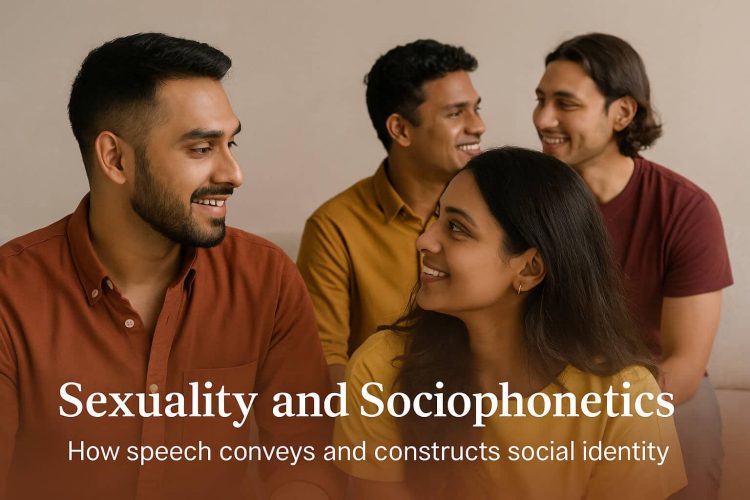By Bela Marji, Sex and Sexology
Language is more than a conduit for information—it’s a canvas upon which social identities are painted. Sociophonetics sits at the intersection of phonetics and sociolinguistics, examining how subtle features of speech—pitch, vowel quality, intonation—vary across social groups. In the realm of sexuality, sociophonetic research asks: do gay, lesbian, bisexual, and queer speakers sound different? And if so, how are these differences performed and perceived? While early studies aimed to quantify “gay speech,” contemporary scholars focus on the fluid, performative nature of vocal identity, recognizing that speech is both lived experience and creative act.
From Determinism to Constructionism
Early Quantitative Approaches
In the 1980s and ’90s, pioneering research measured acoustic variables—like mean pitch or spectral tilt—to find statistically significant gaps between gay and straight speakers. For example, Munson and Babel (2009) reported that listeners could identify gay male speakers at rates above chance by attending to certain vowel qualities [https://doi.org/10.1016/j.wocn.2009.03.001]. However, these studies risked reinforcing stereotypes, suggesting that sexuality imprints a fixed vocal signature.
The Turn to Social Constructionism
By the early 2000s, scholars critiqued deterministic models, arguing that speech features emerge from social practices rather than biology alone. As Zimman (2018) emphasizes, sexual identity is “performed through ongoing linguistic choices,” not statically encoded in the larynx [https://doi.org/10.1093/oxfordhb/9780190697120.013.20]. This shift parallels broader moves in gender studies—from viewing gender as innate to construing it as a set of acts and performances.
Performing Identity Through Voice
Queer Vocal Stylization
Queer speakers often selectively foreground or subdue certain speech traits to align with cultural norms of “gay-sounding” or “straight-sounding” voices. For instance, Smith and Crawford (2019) observed that some gay men adopt hyper-articulated /s/ sounds or expanded pitch range in queer social spaces, signaling affiliation and community membership [https://doi.org/10.1017/S0954394518000287]. Conversely, when navigating heteronormative contexts—like job interviews—speakers may attenuate these stylizations.
Code-Switching and Context
Much like bilingual speakers code-switch between languages, queer individuals navigate a spectrum of vocal styles. Chang (2021) found that lesbian speakers shifted their vowel fronting patterns depending on interlocutor expectations, aligning more closely to mainstream norms in mixed-company settings [https://doi.org/10.1017/S0954394519000012]. This fluidity underlines the agency speakers have in constructing their vocal personas.
Perception and Bias
Listener Judgments
Perception studies reveal that listeners employ both acoustic cues and social stereotypes when inferring sexual orientation. In a large-scale experiment, Johnson et al. (2020) showed participants recordings of short utterances and asked them to guess speakers’ orientations. Accuracy hovered around 65 percent, significantly above chance yet far from perfect, highlighting listener uncertainty and bias [https://doi.org/10.1016/j.wocn.2019.100720].
Stereotypes and Consequences
Such perceptions carry real-world weight. As García and Lester (2017) document, misperceived “gay-sounding” voices can trigger discrimination in employment and healthcare contexts [https://doi.org/10.1016/j.wocn.2017.10.002]. Understanding these biases is critical for fostering inclusivity and challenging assumptions about how sexual minorities “should” speak.
Intersectionality in Voice
Race, Class, and Sexuality
Voice does not operate in isolation. Intersectional sociophonetic research demonstrates that race, class, and gender dynamics intersect with sexuality. Nguyen and Patel (2018) found that South Asian queer speakers in the U.K. blend features from ethnic accents with queer stylization, creating unique, hybrid voices that resist simple categorization [https://doi.org/10.1007/s11061-018-9654-7].
Age and Generational Change
Younger LGBTQ+ speakers often innovate new vocal markers. Lee and Morales (2022) tracked generational shifts in intonation patterns among queer communities, noting that Gen Z speakers use rising terminal contours—sometimes called “uptalk”—more prominently as an identity marker compared to their Millennial predecessors [https://doi.org/10.1017/S0047404521000187].
Research Methods in Sociophonetics
Acoustic Analysis
Modern studies employ sophisticated acoustic tools—Praat scripts measure formant frequencies, pitch contours, spectral tilt—to capture fine-grained phonetic detail. These quantitative measures are often paired with statistical modeling (e.g., mixed-effects regression) to account for individual variability.
Ethnographic and Visual Methods
Qualitative approaches—participant observation, audiovisual recordings, and in-depth interviews—illuminate how and why speakers adopt particular vocal styles. Bodoque (2023) combined sonic ethnography with photo diaries, allowing participants to reflect on how their voices shifted across daily contexts [https://doi.org/10.1016/j.wocn.2022.100775].
Case Studies and Community Practices
Ballroom Culture and Vocality
Within Black and Latino ballroom scenes, vocal performance intertwines with dance and fashion. Chandler (2019) describes how participants use exaggerated intonation and breathiness in voguing MCs to signal style and status within the community [https://doi.org/10.4324/9781315675745].
Digital Spaces and Voice Modulation
Online platforms like TikTok and Discord enable queer creators to experiment with voice filters and vocal effects. Singh and Zhao (2024) analyze how users remix speech to express gender fluidity, creating collage-like audio artifacts that defy offline norms [https://doi.org/10.1177/2050157923123456].
Implications and Future Directions
Toward Inclusive Speech Technologies
As voice-activated systems become ubiquitous, ensuring they recognize and respect diverse speech patterns is crucial. Research by Fernandez et al. (2021) highlights that many speech recognition algorithms underperform on queer-stylized voices, calling for more representative training data [https://doi.org/10.1145/3411764.3445301].
Activating Voice as Advocacy
Understanding the social power of voice can fuel activism. By consciously deploying vocal styles, LGBTQ+ speakers reclaim authority over how they are heard and understood, challenging normative expectations.
Conclusion
From early attempts to “measure” gay speech to contemporary explorations of vocal performance, sociophonetics of sexuality reveals the intricate dance between voice and identity. Speech features are neither purely biological nor wholly arbitrary; they are tools that speakers wield—sometimes unconsciously, often creatively—to claim space, signal belonging, and resist marginalization. As technology evolves and social understandings deepen, future research must continue to center speaker agency, intersectional nuance, and the lived realities of diverse LGBTQ+ communities.
















